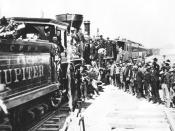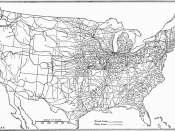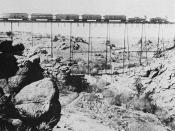Railroads Impact in the United States
Railroads were the first big business, they extended over thousands of miles and employed tens of thousands of workers. The railroads required an immense amount of equipment and facilities; no single person could supervise it alone. The railroad stood as the most visible example of the complexity that came with industrialization. The completion of the transcontinental railroads signalled the new pace of rail development and progress of a better economy in the United States.
Railroads stimulated the national economy. From the late 1860s through the early 1890s, the railroads consumed more than half the nation's output of steel. Railroads brought new methods of management. There was a new relationship between business and government. The railroad was the first business to establish corporate bureaus. The railroads were also very competitive. To survive, a railroad needed a reliable and constant flow of freight and passengers. One strategy was to build tracks and add lines required more business to pay off the cost of building it.
Railroads therefore dealt with a constant struggle of the available traffic. Some railroad business's competed by how much they charged, and gave free passes to those people who travel a lot on that railroad, also by decreasing the shipment of livestock.
For 75 years, railroad companies dominated the economy in America. Making huge amounts of money, like J.P. Morgan, who earned $2 ý billion in railroad stock. It still wasn't enough money for the growth of the business, however. The success of big business came during difficult economic times. The depression of the 1870s, throughout these years deflation brought about by increased productivity, a tight money supply, and an abundant labor force, was a fact of life for all businessmen. Immigrant trains began to form; colonization agents would seek out...



This is good ariticle
We have been using trains since the 20s trading with countrys sending letters to loved ones and visiting other states in less time.
2 out of 2 people found this comment useful.